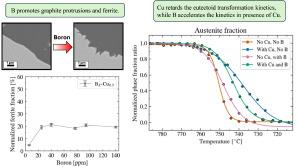B和Cu对球墨铸铁组织和共析转变动力学的影响
IF 2.9
Q2 MATERIALS SCIENCE, MULTIDISCIPLINARY
引用次数: 0
摘要
研究了硼(B)和铜(Cu)对球状石墨铁(SGI)中石墨结核形貌和铁素体分数的影响。在含0.5 wt% Cu和0.7 wt% Mn的全珠光体SGI合金中,B促进了铁素体的形成。对于这种特殊的合金和铸件形状,B的促进作用在大约20ppm饱和,导致铁素体分数为20%。铁素体生长过程中从基体中析出的碳以尖锐的石墨突起的形式沉积在石墨结核上。对于固定浓度B (25 ppm)的合金,将Cu浓度增加到1.2 wt%不能获得完全珠光体基体。透射电镜(TEM)显示,在石墨-铁氧体界面处存在一层纳米厚的Cu层。通过微探针分析,在石墨-铁界面附近检测到B。采用同步x射线原位实验分析了共析相变动力学。结果表明,单独加入B和Cu均能延缓共晶相变动力学。然而,在Cu存在的合金中,B加速了动力学。本文章由计算机程序翻译,如有差异,请以英文原文为准。

Influence of B and Cu on microstructure and eutectoid transformation kinetics in spheroidal graphite cast iron
The influences of boron (B) and copper (Cu) on the morphology of the graphite nodules and fraction of ferrite in spheroidal graphite iron (SGI) have been studied. It was observed that B promotes ferrite in a fully pearlitic SGI alloyed with 0.5 wt% Cu and 0.7 wt% Mn. For this particular alloy and casting shape the ferrite promoting effect of B saturated at approximately 20 ppm, resulting in a ferrite fraction of 20%. The carbon rejected from the matrix during the ferrite growth was deposited on the graphite nodules as sharp graphite protrusions. For an alloy with a fixed concentration of B (25 ppm), a fully pearlitic matrix could not be obtained by increasing the concentration of Cu to 1.2 wt%. Transmission electron microscopy (TEM) showed that a nanometer thick layer of Cu is present at the graphite-ferrite interface. B is detected in close proximity to the graphite-iron interface by using microprobe analysis. In-situ synchrotron X-ray experiments were conducted to analyze the eutectoid transformation kinetics. It shows that both B and Cu retards the eutectoid phase transformation kinetics when they are added individually. However, B accelerates the kinetics in alloys where Cu is present.
求助全文
通过发布文献求助,成功后即可免费获取论文全文。
去求助
来源期刊

Materialia
MATERIALS SCIENCE, MULTIDISCIPLINARY-
CiteScore
6.40
自引率
2.90%
发文量
345
审稿时长
36 days
期刊介绍:
Materialia is a multidisciplinary journal of materials science and engineering that publishes original peer-reviewed research articles. Articles in Materialia advance the understanding of the relationship between processing, structure, property, and function of materials.
Materialia publishes full-length research articles, review articles, and letters (short communications). In addition to receiving direct submissions, Materialia also accepts transfers from Acta Materialia, Inc. partner journals. Materialia offers authors the choice to publish on an open access model (with author fee), or on a subscription model (with no author fee).
 求助内容:
求助内容: 应助结果提醒方式:
应助结果提醒方式:


